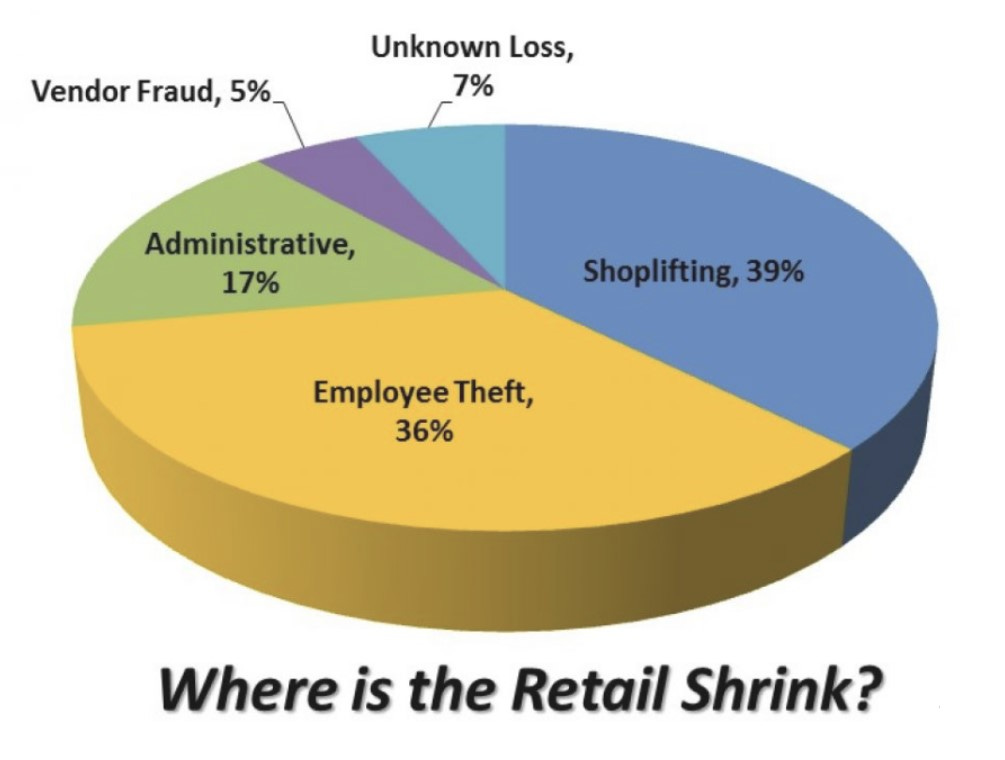Retailers: Theft "Shrinks" Your Bottom Line By 1.6% or More!
Shrink at an all-time high — costing the industry $61.7 billion. Here us what you can do about it!
Shrink, defined as a combination of inventory losses, cash losses, and administrative losses (paperwork errors) have long been a scourge of merchants everywhere. It’s difficult enough to earn a profit in retailing. Losing a portion of those earnings to shrink just stinks.
To address this, many surveys show that retailers are paying more attention and devoting more resources than ever to minimizing shrink. It’s no wonder, given the increasing impact to the bottom line.
The 2020 National Retail Security Survey reports that shrink is at an all-time high, accounting for 1.62% of a retailer’s bottom line and costing the industry $61.7 billion.
$61.7 billion in losses. Wow!
70% of retailers reported a shrink rate of 1% or higher, compared with slightly more than 50% in 2018. Almost twice as many reported shrink rates of 3% or higher in 2019 vs. 2018.
Do you know your shrink percentage for last year? You should. More importantly, do you know how many dollars your business lost to shrink last year? It’s a more impactful number. 2% shrink, while it sounds bad, is not as disturbing as thinking of shrink in terms of dollars. If your retail business did $5 million in sales, that same 2% converts to a $40,000 loss on the bottom line. Pretty painful and certainly worth your attention.
Shrink impacts your business in multiple ways. You certainly lose the capital you invested to purchase products that are shoplifted. You also have an opportunity cost as sales may be reduced due to lower than necessary inventory levels. Out of stocks also create negative consumer perceptions of your store and brand, which could have a long term impact on your business. Cash losses are equally problematic, as your ability to reinvest that capital into growing your business is impacted. Anyway you look at it, shrink is a problem.
You may have read that shrink shrunk in 2020. Don’t be fooled. While temporary store closures due to Covid-19 resulted in fewer retail theft cases, the average shoplifting loss increased 13.0% and the average employee theft loss increased 3.8% over 2019. 2020 was clearly a (bad) record-setting year and with consumers back out in force and stores being open traditional operating hours, 2021 may indeed be even worse.
So let’s define and then dig into prevention tactics for the main contributors to shrink.
External Theft
Shoplifting accounts for nearly 39% of total retail shrink. This category includes shoplifting (stealing merchandise from the salesfloor), falsifying product returns, cash theft via till-tapping or similar, burglary, robbery and check/credit card fraud. Traditional shoplifting is the major contributor in this category.
Internal Theft
Employee theft is a staggering 36% of retail shrink. This category includes stealing products, gift cards, and cash. Cash losses can be direct (grab the money) or incurred through fake refunds, voids, gift cards and a host of other creative transactions such as taking cash for a sale but never scanning the item and pocketing the money. Giving away product to friends or family by not ringing up an item or items is another contributor to internal theft.
Administrative (Paperwork) Losses
Administrative errors, also called book or paper shrink, contribute to almost 17% of a retailer’s shrinkage. These losses may result from under or over-reporting inventory levels, product receipts, markups or markdowns, as well as mismanagement of inventory transfers and in-transit tracking. Businesses which rely on manual systems and processes are more susceptible to this type of shrink.
Supplier Fraud
The smallest contributor to shrinkage, supplier fraud is still a consideration. It’s the cause for nearly 5% of inventory loss. This type of costly fraud may be implemented through a billing scheme where the store is charged for units not delivered, often through duplicate invoices that appear legitimate. Bribery and extortion also occur and may include dishonest employees who work in conjunction with the fraudulent vendor or supplier.
Tactics to Reduce Shrink
Before getting into specifics, there are two things that you can do that will have the greatest impact on shrink, and reducing it dramatically:
Keep reading with a 7-day free trial
Subscribe to All Things Retail to keep reading this post and get 7 days of free access to the full post archives.





